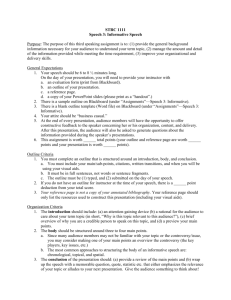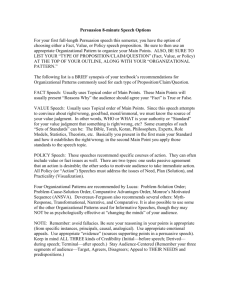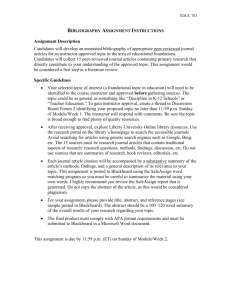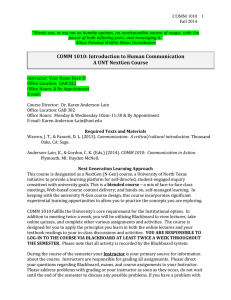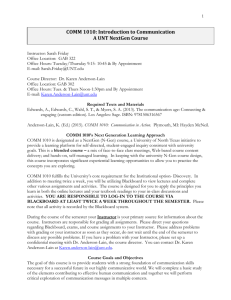STRC 1111 S5 Proposition of Policy Criteria
advertisement
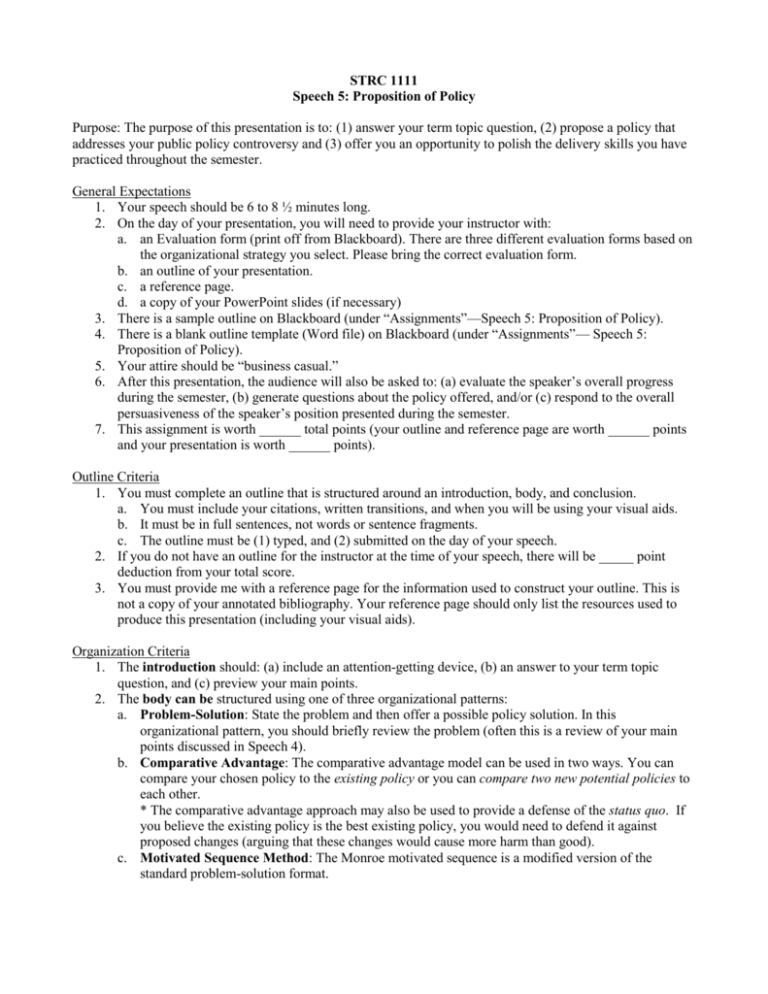
STRC 1111 Speech 5: Proposition of Policy Purpose: The purpose of this presentation is to: (1) answer your term topic question, (2) propose a policy that addresses your public policy controversy and (3) offer you an opportunity to polish the delivery skills you have practiced throughout the semester. General Expectations 1. Your speech should be 6 to 8 ½ minutes long. 2. On the day of your presentation, you will need to provide your instructor with: a. an Evaluation form (print off from Blackboard). There are three different evaluation forms based on the organizational strategy you select. Please bring the correct evaluation form. b. an outline of your presentation. c. a reference page. d. a copy of your PowerPoint slides (if necessary) 3. There is a sample outline on Blackboard (under “Assignments”—Speech 5: Proposition of Policy). 4. There is a blank outline template (Word file) on Blackboard (under “Assignments”— Speech 5: Proposition of Policy). 5. Your attire should be “business casual.” 6. After this presentation, the audience will also be asked to: (a) evaluate the speaker’s overall progress during the semester, (b) generate questions about the policy offered, and/or (c) respond to the overall persuasiveness of the speaker’s position presented during the semester. 7. This assignment is worth ______ total points (your outline and reference page are worth ______ points and your presentation is worth ______ points). Outline Criteria 1. You must complete an outline that is structured around an introduction, body, and conclusion. a. You must include your citations, written transitions, and when you will be using your visual aids. b. It must be in full sentences, not words or sentence fragments. c. The outline must be (1) typed, and (2) submitted on the day of your speech. 2. If you do not have an outline for the instructor at the time of your speech, there will be _____ point deduction from your total score. 3. You must provide me with a reference page for the information used to construct your outline. This is not a copy of your annotated bibliography. Your reference page should only list the resources used to produce this presentation (including your visual aids). Organization Criteria 1. The introduction should: (a) include an attention-getting device, (b) an answer to your term topic question, and (c) preview your main points. 2. The body can be structured using one of three organizational patterns: a. Problem-Solution: State the problem and then offer a possible policy solution. In this organizational pattern, you should briefly review the problem (often this is a review of your main points discussed in Speech 4). b. Comparative Advantage: The comparative advantage model can be used in two ways. You can compare your chosen policy to the existing policy or you can compare two new potential policies to each other. * The comparative advantage approach may also be used to provide a defense of the status quo. If you believe the existing policy is the best existing policy, you would need to defend it against proposed changes (arguing that these changes would cause more harm than good). c. Motivated Sequence Method: The Monroe motivated sequence is a modified version of the standard problem-solution format. 3. For the conclusion: (a) provide a review of your main points, (b) propose a course of action for the audience to take to help enact your solution, and (c) wrap up your speech with a memorable question or point that emphasizes your position and/or proposed policy. Content Criteria 1. You are proposing a policy—a course of action that we as a community, nation, group of people, and/or government should take. Your policy should be sensible and practical. While your solution does not have to be (nor could it be) perfect, it should be a reasonable approach that reflects your understanding of your audience and the term topic. a. Your proposed policy can be: (1) a completely new policy that you have created, (2) it can be a new policy that someone else has suggested (a politician, an advocacy group, proposed legislation, etc.), (3) suggest specific changes to the existing policy, or (4) a defense of the status quo. If you use an existing or a proposed policy, be sure to cite the source of your information. b. You need to clearly state why your policy is more beneficial or better than the existing policy. You need to provide evidence from reputable sources that support your policy. You should provide at least three pieces of evidence supporting your proposition of policy. 2. It is important that in the conclusion of your speech you direct the audience to a course of action: Your proposed course of action should be as specific as possible. a. What should the audience do to help solve the problem? Should they take direct action in their own lives? How? Should they attempt to influence the agent of change? How? b. For example, you can direct them to a specific website to complete a form letter, provide the contact information for a specific representatives they can contact, or identify a specific organizations to whom they can donate money. 3. You are not required to use a visual aid. However, you will be evaluated on whether one would have been helpful and/or how effective any visual aids were in presenting the material. Delivery Criteria 1. You should look to fine tune all aspects of your delivery. It is particularly important in this speech to show that you have made progress in improving the areas of your delivery that required the most improvement. You may want to refer back to your self evaluation and/or the comments from your audience and the instructor that related to your delivery. 2. Your mode of delivery should be extemporaneous. You may use one note card to aid you in your delivery or an electronic device. 3. In this presentation, you want to build on the delivery skills practiced in speeches 2-4. 4. For this final speech you are not required to be “objective” and “neutral” in your presentation of the material. There is a particular importance, then, placed on using the appropriate persuasive tone (exemplified in your vocal variety, paralinguistics, use of space, etc). Again, however, you should be aware that how you present the material will influence how people interpret the information. 5. There is a standard grade penalty for not meeting or exceeding the time limit (1 point from your total score for every 10 seconds under or over). The instructor reserves the right to amend these criteria as necessary.
